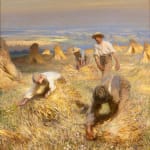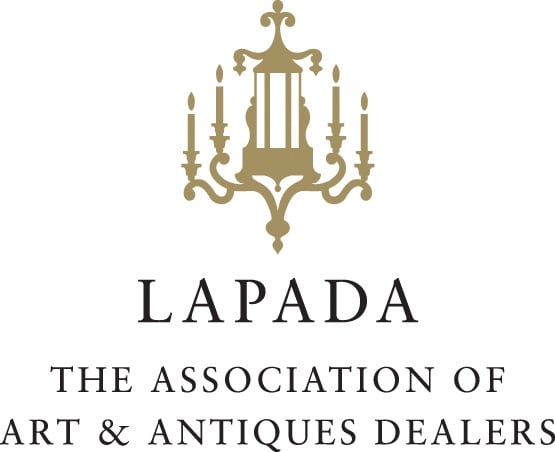George Clausen 1852-1944
Framed: 103.5 x 94.5 cm.; 40¾ x 37 in.
During the final quarter of the nineteenth century, conditions in the English countryside preoccupied writers and artists. With imperial expansion, the rapid growth of cities and the ready availability of cheap foodstuffs from North America, agricultural production was in decline. Britain, which led the world in industrial mechanization, was slow to modernize its farming processes. Alongside the continued reliance upon labour intensive methods, an impressive rearguard action was mounted by Edwardian intellectuals who sought to justify healthy outdoor work, in contrast to that of the factory. The countryside embodied healthiness and the city, degeneracy. George Clausen was central to this cultural movement, and within his work, the groups of pictures of field work, rick-building and grain-sifting, painted around 1900, are its pictorial archetypes.
The field gang pictures, principally, Sons of the Soil, (private collection, R.A. 1901, no. 378), the present work of 1902, and Harvest: In the Bean Field (1904, Durban Art Gallery), show different stages of crop production, from seed-time through to harvest. The cool spring palette used for the painting of a group of men hoeing in Sons of the Soil, gives way to the rich golden glow of the present work. The fact that the laboureres are few in number reminds us that the period of large itinerant gangs had passed, and that by 1900, harvesting depended upon smaller groups based upon old tithed families. Boys, men and old men would work together. Here Clausen accentuates the rhythmic, co-ordinated activity of the group by emphasising the movement of hands and forearms. There are no tools for this task. Two foreground labourers, one dramatically foreshortened, are bent over their work, gathering the final sheaves at the edge of the field, here indicated by a patch of rough soil and some wild meadow flowers at the bottom edge of the canvas. Once collected and tied, the sheaves are stacked upright in groups of five or six, in a stook. Dots of colour in the middle distance, indicate that this same activity is going on in a far off field, while the striding harvester on the right, with his swinging arms and massive hands, provides an almost symbolic presence in what must be considered one of the most expressive of Clausen’s works.
Clausen had tackled this subject before, around 1890, in his sub-Bastien-Lepage manner. However, the two most important precedents for the present work were the much criticised Harvest (untraced; R.A. 1895, no. 91) and Setting up Sheaves (untraced, formerly Lady Plender; R.A. 1900, no. 4). The second of these won considerable favour, being praised by The Magazine of Art for its ‘brilliancy of illumination and daintiness of aerial colour’. Taking a close-up view of two labourers, gathering and setting up sheaves, Clausen delights in the fanning strokes of pigment used for the corn stooks, which imitate pastel, a preferred medium of the period. This canvas formed the basis of Harvest, Tying the Sheaves, a work, so successful in itself, that the painter produced a later, simpler variant of the composition, Binding Sheaves (private collection). Drawings related to this sequence of compositions are retained in the Royal Academy (particularly Sketchbook 21, 1902).
As is clear from the contemporary canvases of Léon Lhermitte, Julien Dupré and others, these simple practices were also consistent with French agriculture of the period, although in France, men and women worked together in tying the sheaves. Where Lhermitte habitually deployed a landscape format for such a scene, showing a line of workers cutting into the corn, Clausen accentuates the visual drama by allowing more air around his figures, in an upright presentation. The landscape itself is more than simply a backdrop against which his figures perform: they progress through it, defining their spatial relationships as they move. The painter was preoccupied with movement, as his sketchbooks of the period indicate. He had first experimented with this format in Summer in the Fields, (sold Christie’s, New York, 22 October 1997, lot 142), a picture of two girls resting on an open hillside, overlooking an expanse of fields near the painter’s home at Widdington in Essex. As with the Impressionists, Clausen was preoccupied with the concept of an ‘envelope’ of coherent atmosphere in which figures, foreground, middle distance and background are all seen together and partake of the same palette. This is especially clear in the present work where, in a palette reminiscent of Van Gogh’s gleaners and harvesters, after Millet, the brilliant blues, mauves, ochres and whites reverberate throughout the canvas.
The picture was dispatched to Thomas Agnew in December 1902, and presumably passed immediately to his client, Charles Galloway, a Cheshire industrialist who owned a number of fine rustic pictures, including Henry La Thangue’s An Autumn Morning (1897, private collection). By 1910, when the picture was shown in Manchester, it had passed to Clausen’s most important early patron, the Lincoln retailer, Sharpley Bainbridge, who owned early works like Labourers after Dinner (1884, private collection) and The Mowers (1891, Usher Gallery, Lincoln). In 1927, Barbizon House Record, referring to Harvest, Tying the Sheaves noted that, ‘the less scientific, less logical, more wayward, more charming English impressionists, Wilson Steer and Clausen, made Impressionism affectionate, with a sort of English wildflower poetry.’
James Bones, Barbizon House Record
Kenneth McConkey
Provenance
Agnews, London, December 1902
C. J. Galloway, 1905
Sharpley Bainbridge, Hatfield House, Lincoln, by 1910
His sale, Christie's, London, 10 February 1922, lot 110 (310 gns. to Thomson)
David Croal Thomson, Barbizon House, London;
Private Collection, 1927, by descent
Christie's, London, 30 November 2000, lot 26
Private Collection
Exhibitions
Manchester, City Art Gallery, Exhibition of Modern Paintings, Drawings and Prints, 1910, no. 88Pennsylvania, Pittsburgh, Carnegie Institute, no. 97 (not traced)
Ottawa, National Gallery of Canada, Exhibition of Contemporary British Paintings, 1915, no. 23
Literature
The Barbizon House Collection, The Studio, February 1923, p. 106 (illustrated as the frontispiece)The Barbizon House Record, 1927, no. 30 (illustrated)
Christopher Wood, Paradise Lost, Portraits of English Country Life and Landscape 1850-1914, London, 1988, p. 89, pl. 77
Kenneth McConkey, George Clausen and the Picture of English Rural Life, 2012, Atelier Books, Edinburgh, pp.129-130 (illustrated)
Join our mailing list
Be the first to hear about our upcoming exhibitions, events and news
* denotes required fields
We will process the personal data you have supplied to communicate with you in accordance with our Privacy Policy. You can unsubscribe or change your preferences at any time by clicking the link in our emails.




